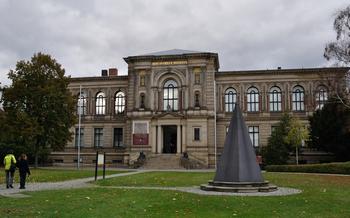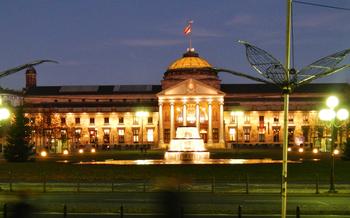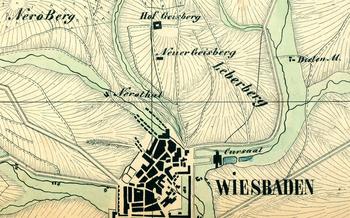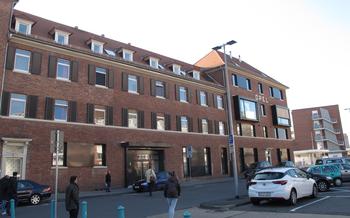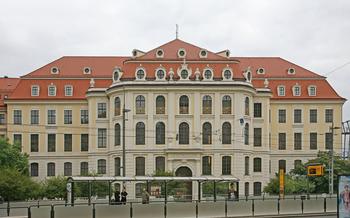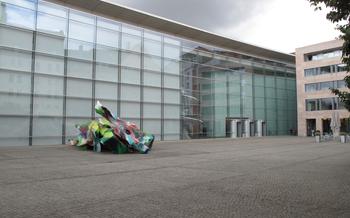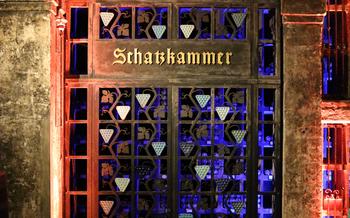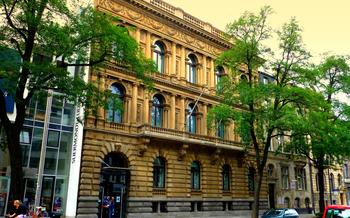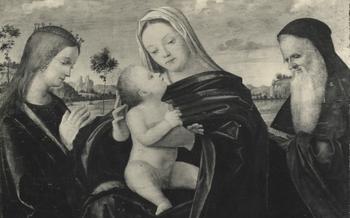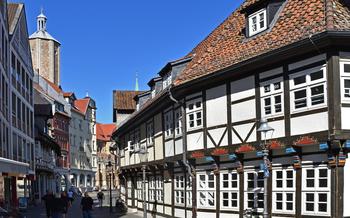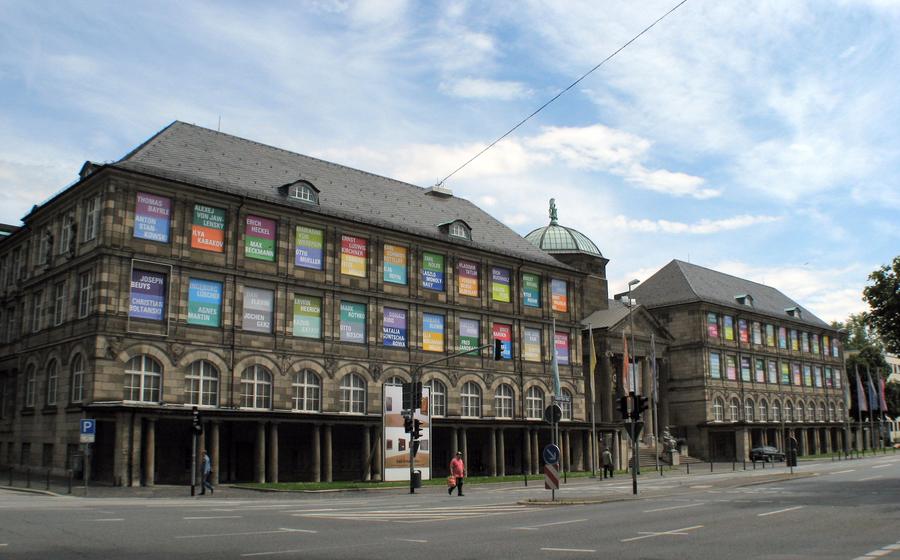
The Wiesbaden Museum
- The Wiesbaden Museum: A Journey Through History and Art
- Permanent Exhibitions: A Treasure Trove of Art and Culture
- Natural History Collection: Exploring the Wonders of Nature
- Temporary Exhibitions: A Showcase of Contemporary Art
- Guided Tours: Unveiling the Museum's Secrets
- Educational Programs: Engaging with the Museum's Collections
- Research and Conservation: Preserving Wiesbaden's Heritage
- Accessibility and Facilities: Welcoming All Visitors
- Museum Shop: Unique Souvenirs and Gifts
- Special Events and Activities: Bringing the Museum to Life
- Location and Transportation: Conveniently Situated in the Heart of Wiesbaden
- Hours of Operation and Admission Fees: Planning Your Visit
- Online Resources and Virtual Tours: Exploring the Museum from Afar
- Accessibility and Accessibility Features: Ensuring a Welcoming Experience for All
- Insider Tip: Hidden Gems and Secret Spots
The Wiesbaden Museum: A Journey Through History and Art
Wiesbaden Museum, a treasure trove of history and art, invites visitors on a journey through time and culture. Founded in 1825, the museum has played a pivotal role in preserving and showcasing the rich heritage of Wiesbaden and the surrounding region. Housed in a stately neoclassical building, the museum's impressive architecture is a testament to its significance and grandeur. Inside, visitors are greeted by a diverse collection of artifacts, paintings, sculptures, and exhibits that narrate the story of Wiesbaden's past and present. From ancient Roman remains to medieval tapestries and contemporary artworks, the museum offers a captivating exploration of the city's cultural and artistic legacy.
Permanent Exhibitions: A Treasure Trove of Art and Culture
The Wiesbaden Museum houses a diverse array of permanent exhibitions, showcasing a comprehensive journey through art and culture. Among the highlights are the impressive collection of ancient Roman artifacts and sculptures, providing a glimpse into the region's rich history. These artifacts include intricate mosaics, finely carved statues, and everyday objects, offering insights into the lives and customs of the Roman inhabitants.
The museum also boasts an extensive collection of medieval and Renaissance paintings and tapestries, showcasing the artistic achievements of these periods. Visitors can admire the vibrant colors and intricate details of works by renowned artists, such as Lucas Cranach the Elder and Hans Holbein the Younger. These masterpieces depict religious scenes, historical events, and portraits of notable figures, offering a glimpse into the artistic and cultural climate of the Middle Ages and Renaissance.
In addition, the museum features a significant collection of modern and contemporary art from German and international artists. This section includes paintings, sculptures, installations, and mixed media works that explore a wide range of themes and styles. From abstract expressionism to pop art and conceptual art, these works challenge conventional notions and offer fresh perspectives on the art of the 20th and 21st centuries.
Natural History Collection: Exploring the Wonders of Nature
The Wiesbaden Museum is home to an extensive natural history collection that showcases the rich biodiversity of the region. This collection features an array of fossils and minerals from the surrounding area, providing visitors with a glimpse into the geological history of Wiesbaden. Exhibits on local flora and fauna further enhance the museum's exploration of the natural world, highlighting the diverse ecosystems and species that thrive in this vibrant region.
Interactive displays and hands-on activities make this section of the museum particularly engaging for children and families. Young visitors can learn about the wonders of nature through interactive exhibits, fossil-hunting simulations, and up-close encounters with replica dinosaur skeletons. The natural history collection at the Wiesbaden Museum not only educates and informs, but also inspires a sense of curiosity and appreciation for the natural world.
Temporary Exhibitions: A Showcase of Contemporary Art
The Wiesbaden Museum's commitment to contemporary art is evident in its dynamic program of temporary exhibitions. These rotating shows feature works from renowned artists across the globe, showcasing a diverse range of artistic styles and movements. Thematic exhibitions explore specific art movements or periods, inviting visitors to delve deeper into the history and significance of modern and contemporary art.
Collaborative projects with other museums and galleries bring fresh perspectives and unique artworks to Wiesbaden. These collaborations provide a platform for emerging artists to showcase their work and foster cross-cultural exchange. The temporary exhibitions at the Wiesbaden Museum are a vibrant and ever-changing showcase of the latest trends and developments in the art world, offering visitors a glimpse into the creative minds of our time.
Guided Tours: Unveiling the Museum's Secrets
Discover the hidden stories and insights behind the Wiesbaden Museum's vast collections through expertly guided tours. Led by knowledgeable and passionate guides, these tours offer a unique opportunity to delve deeper into the history and significance of the museum's treasures. From ancient Roman artifacts to modern masterpieces, each tour provides a personalized and enriching experience.
Specialized tours are available for groups, families, and school children, catering to diverse interests and learning levels. Advance booking is recommended to secure your spot and enjoy group discounts. Let the museum's guides take you on a journey through time and art, revealing the secrets and wonders that await within these hallowed halls.
Educational Programs: Engaging with the Museum's Collections
The Wiesbaden Museum offers a diverse range of educational programs designed to engage visitors of all ages with its rich collections and exhibitions. Through workshops, lectures, and demonstrations, the museum provides a platform for learning and exploration. Visitors can participate in hands-on activities, gain insights from experts, and discover the fascinating stories behind the artifacts on display.
Workshops cater to a variety of interests and skill levels, allowing participants to delve deeper into specific areas of the museum's collection. From painting and drawing classes inspired by the old masters to interactive sessions on natural history and archaeology, these workshops offer a unique opportunity to learn from experienced instructors and create their own works of art.
Lectures by renowned scholars and experts provide in-depth knowledge on various topics related to the museum's collections. These lectures cover a wide range of subjects, from the history of ancient Rome to the evolution of modern art. Visitors can gain insights into the latest research and discoveries, and engage in thought-provoking discussions with experts in the field.
Demonstrations offer a unique opportunity to witness the creative process firsthand. Skilled artisans and conservators showcase their techniques and provide insights into the restoration and preservation of the museum's artifacts. Visitors can learn about the materials and methods used in creating works of art and gain a greater appreciation for the skill and craftsmanship involved.
The museum's educational programs are designed to foster a love of learning and encourage visitors to explore the world of art and history. By providing interactive and engaging experiences, the museum creates a dynamic environment where visitors can learn, create, and discover the wonders of the past and present.
Research and Conservation: Preserving Wiesbaden's Heritage
The Wiesbaden Museum is not just a place to display artifacts and artworks but also a center for research and conservation. The museum's dedicated team of experts is committed to preserving Wiesbaden's rich heritage and ensuring the longevity of its collections. Ongoing research projects delve into the history, significance, and techniques behind the artifacts, shedding new light on Wiesbaden's past.
Conservation efforts play a crucial role in protecting and restoring the museum's treasures. Skilled conservators employ specialized techniques to repair and maintain artifacts, ensuring their preservation for future generations. The museum collaborates with universities and research institutions to advance conservation methods and share knowledge with the wider community.
Through research and conservation, the Wiesbaden Museum fulfills its mission to safeguard the city's cultural heritage and make it accessible to visitors from around the world.
Accessibility and Facilities: Welcoming All Visitors
The Wiesbaden Museum is committed to providing a welcoming and accessible experience for all visitors. The museum is wheelchair accessible throughout, with ramps and elevators to all floors. Family-friendly amenities, including baby changing stations and stroller parking, are available. Audio guides and multilingual materials are available to enhance the visitor experience. The museum's website also offers a range of accessibility features, including closed captions for videos and transcripts for audio content. With its inclusive approach, the Wiesbaden Museum ensures that everyone can enjoy and appreciate its rich collections and exhibitions.
Museum Shop: Unique Souvenirs and Gifts
The Wiesbaden Museum's shop is a treasure trove of unique souvenirs and gifts that allow visitors to take a piece of the museum's history and culture home with them. Here, visitors can browse a wide selection of books, prints, and postcards that delve deeper into the museum's collections and exhibitions, offering insights and perspectives on the diverse artworks and artifacts on display.
In addition to these educational materials, the shop also offers a variety of locally crafted souvenirs and gifts inspired by Wiesbaden's rich history and vibrant culture. From traditional Hessian pottery to intricate glass ornaments, visitors can find unique items that capture the essence of this charming city.
The proceeds from the museum shop play a vital role in supporting the museum's educational programs and conservation efforts, ensuring that the museum can continue to preserve and share its rich heritage with visitors from around the world.
Special Events and Activities: Bringing the Museum to Life
The Wiesbaden Museum is not just about preserving the past but also about engaging with the present and the future. It regularly hosts a variety of special events and activities that bring the museum to life and make it a vibrant community space. These events aim to foster creativity, encourage dialogue, and provide unique experiences for visitors of all ages.
One of the highlights is the annual "Museum Night," where the museum stays open late and offers a diverse program of activities, including guided tours, workshops, performances, and live music. This is a great opportunity to explore the museum in a new light and experience it in a festive atmosphere.
The museum also organizes thematic festivals and celebrations throughout the year, showcasing local culture and traditions. These events often involve collaborations with local artists, musicians, and community groups, creating a vibrant and inclusive environment.
For those interested in delving deeper into the museum's collections, there are regular lectures, workshops, and demonstrations led by experts and curators. These events provide insights into the history, techniques, and significance of the artworks and artifacts on display.
To foster a sense of community and encourage engagement, the museum also hosts opportunities for visitors to interact with artists and curators. Through artist talks, workshops, and studio visits, visitors can gain firsthand knowledge and insights into the creative process and the lives of the artists.
These special events and activities not only enhance the visitor experience but also contribute to the museum's mission of promoting cultural exchange, fostering creativity, and preserving Wiesbaden's rich heritage for future generations.
Location and Transportation: Conveniently Situated in the Heart of Wiesbaden
The Wiesbaden Museum enjoys a prime location in the heart of the city, making it easily accessible by public transportation and private vehicles. Several bus and tram lines stop nearby, providing convenient connections to other parts of Wiesbaden and the surrounding region. The museum's proximity to other attractions, such as the picturesque Kurpark and the grand Wiesbaden Casino, makes it an ideal starting point for a day of exploration and cultural immersion.
For those arriving by car, ample parking options are available in the vicinity of the museum. Designated parking spaces for visitors with disabilities are also provided, ensuring a hassle-free experience for all. Whether you choose to walk, take public transportation, or drive, the Wiesbaden Museum is conveniently situated for a seamless and enjoyable visit.
Hours of Operation and Admission Fees: Planning Your Visit
The Wiesbaden Museum is open to the public from Tuesday to Sunday, from 10 am to 6 pm. On Mondays, the museum is closed. Admission fees vary depending on the type of ticket and any special exhibitions that may be on display. A standard ticket for adults costs 10 euros, while reduced tickets for students, seniors, and families are available at a discounted rate of 7 euros. Children under the age of 6 can enter the museum for free. The museum also offers free admission on the first Sunday of every month. Visitors can purchase tickets online or at the museum's ticket counter. It is advisable to check the museum's website for any updates or changes to opening hours and admission fees before planning your visit.
Online Resources and Virtual Tours: Exploring the Museum from Afar
The Wiesbaden Museum offers a range of online resources and virtual tours to provide visitors with a comprehensive experience, even from the comfort of their own homes. These resources include:
-
Interactive Virtual Tours: Take a virtual stroll through the museum's galleries and exhibitions, with 360-degree views and detailed information on each artwork or artifact. Explore at your own pace, zoom in on specific details, and learn about the history and significance of each piece.
-
Digital Catalogs and Educational Materials: Access digital catalogs of the museum's collections, featuring high-resolution images, descriptions, and contextual information. Educational materials, such as worksheets, lesson plans, and activity sheets, are also available for download, making the museum's resources accessible to teachers, students, and families for educational purposes.
-
Podcasts and Online Lectures: Listen to informative podcasts and online lectures by museum experts, curators, and guest speakers on various topics related to the museum's collections and exhibitions. These audio resources provide insights into the museum's history, art movements, and the stories behind the artworks.
-
Social Media Presence: Stay connected with the Wiesbaden Museum through its active social media channels. Follow the museum on platforms like Facebook, Twitter, and Instagram for regular updates on events, exhibitions, news, and behind-the-scenes glimpses into the museum's activities.
Accessibility and Accessibility Features: Ensuring a Welcoming Experience for All
The Wiesbaden Museum is committed to providing an inclusive and welcoming environment for all visitors, regardless of their abilities. The museum is fully wheelchair accessible, with ramps and elevators throughout the building. Audio guides and tours are available for visitors with disabilities, and there are services for visitors with visual or hearing impairments. The museum staff is also happy to provide assistance to any visitors who may need it.
In addition to these accessibility features, the Wiesbaden Museum also offers a number of programs and services that are designed to make the museum more welcoming and enjoyable for visitors with disabilities. For example, the museum offers sensory-friendly tours, which are designed for visitors with autism or other sensory sensitivities. The museum also offers a variety of programs for visitors with dementia and their caregivers.
With its commitment to accessibility and its wide range of programs and services, the Wiesbaden Museum is a great place for visitors of all abilities to enjoy art and history.
Insider Tip: Hidden Gems and Secret Spots
For those who venture beyond the main exhibition halls, the Wiesbaden Museum holds a treasure trove of hidden gems and secret spots. Discover the intricate details of the medieval tapestries in the Renaissance gallery, where the vibrant colors and delicate needlework transport you back in time. In the natural history collection, seek out the fossilized remains of a saber-toothed tiger, a reminder of the region's prehistoric past.
For a moment of tranquility, retreat to the museum's inner courtyard, a hidden oasis adorned with sculptures and lush greenery. Capture Instagram-worthy shots of the museum's stunning architecture, with its ornate facade and grand entrance. And don't miss the secret room tucked away behind the main gallery, where you can uncover forgotten artifacts and intriguing stories from Wiesbaden's rich history.
